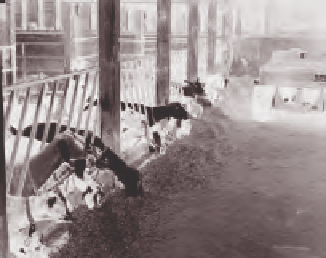Agriculture Reference
In-Depth Information
of condensation, dry and clean bedding areas, feeders and
waterers free from contamination, and facilities that
provide easy access for the animals and that are labor
effi cient.
Dairy goats are comfortable in temperatures ranging
from 13 - 21 ° C (55 - 70 ° F), and they are less sensitive to
lower temperatures
ment. Goats freely move to the feeding or exercise areas.
Feeders and waterers are usually located away from
bedding areas and on concrete pads to reduce
contamination.
In many areas in the U.S., old dairy cattle barns
are modifi ed and used for goats. Pole barns can be
constructed for dairy goats with pressure-treated
posts, native lumber for siding, and metal sheets roofs
(Figure 17.4). High ceiling and sidewall curtains can help
in better ventilation, and open-feeding alleys can provide
for mechanical feeding and cleaning. It is recommended
to keep all the animals and equipment fl ow in a straight
line by avoiding turns for a smooth and safer operation
(Porter, 2009 ).
Fabric-covered hoop structures can be used as a low-
cost dairy housing. These structures are fl exible and can
be moved if needed. Feeding or access alleys can be
designed to keep animals away from damaging the fabric
walls (Figure 17.5 ) (Porter, 2009 ).
Housing for kids and young stock is included in the
housing plans but separate from the milking herd. Bucks
are housed separately downwind from the milking herd in
the buck pen with adequate shelter and exercise area, and
feeders and waterers.
18 to +13 ° C (0 - 55 ° F) than tempera-
tures of 27°C (80°F) and higher. Feed intake and milk
production decreases in high environmental temperatures.
As for all confi nement housing, dairy buildings should be
properly ventilated to remove heat, moisture, and odors.
Condensation on walls and ceilings is the result of poor
ventilation and improper insulation. Adequate natural
lighting through windows will permit sunlight to provide
vitamin D and warmth for animals, and will help in drying
the facility. Windows need to be constructed in such a way
that they can be closed with shades easily to ensure year-
round breeding and milk supply in winter.
Dairy goats are either housed in “loose housing” where
animals run loose in pens, or in “stall barns” where animals
are tied in the individual stalls (Appleman and Ace, 1992).
Loose housing provides adequate bedding, free movement,
ample exercise area, and warmth from the pen mates, and
if constructed properly, is easy to clean. However, built-up
manure can release moisture in the air, and spilled water
or feed can soil bedding and provide for fl y breeding and
contaminants for parasite buildup. These are usually cold
housing facilities that are ventilated by natural air move-
−
Milking Facility or Parlor
The milking area should be separated from the bedding
area. A holding area for animals before entering the
26-foot width
39-foot width
52-foot width
Post-frame building
Open feeding alley
NRAES publication #1
Andy and Jenny Tapper Farm,
Brookfield, NH
Figure 17.4
Post-frame building width and confi gurations and pen feeding alley access area.
Courtesy: John C. Porter, Professor and Dairy Specialist, University of New Hampshire Cooperative
Extension, www.umaine.edu/animalsci/Sheepgoats/Dairy%20Goat%20Housing.ppt. For color detail,
see Appendix A.








